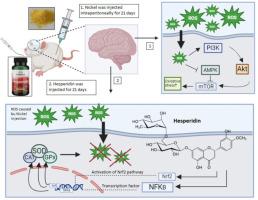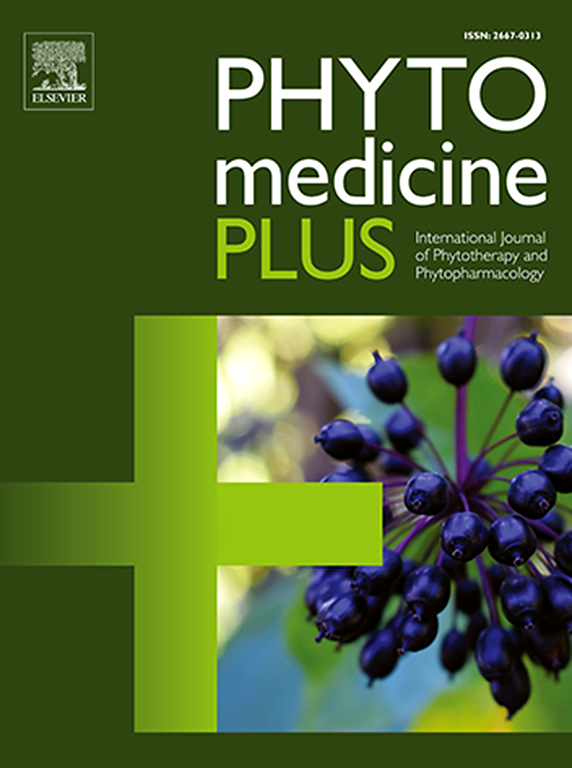橙皮苷对氯化镍暴露大鼠脑内抗氧化酶的调节作用
Q3 Pharmacology, Toxicology and Pharmaceutics
引用次数: 0
摘要
本研究旨在探讨橙皮苷对镍暴露大鼠脑内抗氧化酶过氧化氢酶(Cat)、超氧化物歧化酶(Sod)和谷胱甘肽过氧化物酶(Gpx)基因表达及脑内和血清内酶活性的影响。方法48只雄性Wistar大鼠分为6组:对照组、镍组(氯化镍20 mg/kg)、橙皮苷组(100 mg/kg)和镍+橙皮苷组(剂量分别为50、100、200 mg/kg)。大鼠灌胃给予橙皮苷,腹腔注射镍,持续21 d。采用定量聚合酶链反应(qPCR)检测Sod、Cat和Gpx酶的基因表达,采用标准生化方法检测血清和脑组织中这些酶的活性。免疫组化分析脑组织中Sod1蛋白的表达。结果氯化镍对大鼠脑组织和血清组织Sod、Cat和Gpx酶活性均有显著抑制作用(P < 0.05 ~ P < 0.01)。200 mg/kg橙皮苷显著恢复脑内Sod和Cat活性,分别约为95.74%和80.35% (P < 0.05),所有剂量(50-200 mg/kg)均增加Gpx活性(P < 0.01 ~ P < 0.001)。在血清中,橙皮苷100mg /kg(44.36±13.7 U/mL)和200mg /kg(47.78±6.23 U/mL)剂量组与镍暴露组(19.17±8.20 U/mL)相比,Cat活性显著提高(P < 0.01)。与镍组(16.60±3.67)相比,200 mg/kg剂量显著提高Sod活性(36.78±9.86 U/mL) (P < 0.001)。镍显著下调Cat和Gpx基因表达(P < 0.01 ~ P < 0.001),橙皮苷处理后无恢复。相反,所有剂量的橙皮苷均显著上调Sod基因表达(P < 0.01 ~ P < 0.001)。镍显著降低脑内Sod1蛋白表达(P < 0.0001),而橙皮苷在所有剂量下均增加其表达(P < 0.01 ~ P < 0.0001)。结论橙皮苷对镍引起的氧化损伤具有明显的保护作用,特别是大剂量橙皮苷对镍引起的氧化损伤具有明显的保护作用。本文章由计算机程序翻译,如有差异,请以英文原文为准。

Role of hesperidin in modulating antioxidant enzymes in the brain of rats exposed to Nickel Chloride
Background
This study aimed to investigate the effects of hesperidin on the gene expression of antioxidant enzymes catalase (Cat), superoxide dismutase (Sod), and glutathione peroxidase (Gpx) in the brain and their enzymatic activities in the brain and serum of rats exposed to nickel.
Methods
Forty-eight male Wistar rats were divided into 6 groups: control group, nickel group (nickel chloride 20 mg/kg), hesperidin group (100 mg/kg), and three nickel + hesperidin groups at doses of 50, 100, and 200 mg/kg. Hesperidin was administered via gavage, and nickel was injected intraperitoneally for 21 days. The gene expression of Sod, Cat, and Gpx enzymes was examined using quantitative polymerase chain reaction (qPCR), and the activity of these enzymes in serum and brain tissue was assessed by standard biochemical methods. Immunohistochemistry was also used to analyze the expression of Sod1 protein in brain tissue.
Results
Exposure to nickel chloride significantly suppressed Sod, Cat, and Gpx enzymatic activities in both brain and serum tissues of rats (P < 0.05 to P < 0.01). Hesperidin at 200 mg/kg significantly restored Sod and Cat activities in the brain by approximately 95.74 % and 80.35 %, respectively (P < 0.05), and all doses (50–200 mg/kg) increased Gpx activity (P < 0.01 to P < 0.001). In serum, hesperidin administration at doses of 100 mg/kg (44.36±13.7 U/mL) and 200 mg/kg (47.78±6.23 U/mL) significantly increased Cat activity compared with the nickel-exposed group (19.17±8.20 U/mL) (P < 0.01). Moreover, the 200 mg/kg dose markedly enhanced Sod activity (36.78±9.86 U/mL) relative to the nickel group (16.60±3.67) (P < 0.001). Nickel significantly downregulated Cat and Gpx gene expression (P < 0.01 to P < 0.001), with no recovery after hesperidin treatment. In contrast, hesperidin at all doses significantly upregulated Sod gene expression (P < 0.01 to P < 0.001). Sod1 protein expression in the brain was markedly reduced by nickel (P < 0.0001), while hesperidin increased its expression at all doses (P < 0.01 to P < 0.0001).
Conclusion
Hesperidin, especially at higher doses, shows significant protective effects against nickel-induced oxidative damage.
求助全文
通过发布文献求助,成功后即可免费获取论文全文。
去求助
来源期刊

Phytomedicine Plus
Medicine-Complementary and Alternative Medicine
CiteScore
3.70
自引率
0.00%
发文量
178
审稿时长
81 days
期刊介绍:
 求助内容:
求助内容: 应助结果提醒方式:
应助结果提醒方式:


